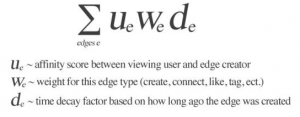A Commentary on EdgeRank
Since we had learned about PageRank in class, I was curious to see what other kinds of ranking algorithms existed as well. After all, while PageRank is a useful metric for accomplishing the specific task of making a good search engine, it’s obviously not applicable to every kind of ranking system. Thus, I did some quick research on to see if any other prominent companies used any of their own type of ranking algorithm.
I stumbled upon EdgeRank, which was Facebook’s primary algorithm for determining what shows up in a user’s newsfeed for several years. Essentially, this algorithm works as follows: every action that a user takes represents an “edge”. For example, writing a status, commenting on something, or liking a page would all be edges. Each of these edges represents a story that can show up in a user’s newsfeed. Given this, the newsfeed is sorted by the most “interesting” stories first, with the following formula:
So what do these variables mean exactly? First, affinity measures the “closeness” between the user the created the edge and the potential viewer. For instance, if I have a friend who I frequently interact with on Facebook through comments, likes, or share many mutual friends with, I will have a high affinity score with that friend. Second, each edge has a different weight assigned to it depending on the type of activity. That is, likes only have a small amount of weight since they typically have low-involvement. However, comments or photos (activities that contain more information/effort) have a much higher weight. Finally, there is a time decay factor; stories that occurred a long time ago carry less weight than stories that recently occurred.
I thought that EdgeRank was a rather elegant solution to the problem that Facebook faced. It’s a very simple formula, but intuitively captures many important aspects that, in my personal opinion, would make a good newsfeed. It’s interesting to note that it parallels PageRank in its simplicity and effectiveness – it’s not terribly complicated, but still does a pretty good job at what it’s set out to accomplish. Additionally, while it’s currently still an important metric, it’s only one of many factors that Facebook considers now in its current newsfeed algorithm, as Facebook also makes extensive use of machine learning in its new algorithm. Again, this is yet again similar to PageRank in the sense that it is also an important metric, but not the sole factor that one can use to make a good search engine nowadays.
It’s also interesting to think about how this algorithm could be applied to other social networks, such as Twitter. There could definitely be ways to apply features of Twitter to fit the variables that we defined above. For instance, users that retweet or favorite other users’ tweets frequently would have higher affinity, and favorites could hold higher weight than retweets. Would it be entirely useful, however? Possibly, possibly not, but it could be used as one of a variety of factors to make a Twitter feed better. Maybe even some kind of combination of hubs/authorities and EdgeRank would be effective as well. It seems as if there are many ways to rank content in social networks.
source: edgerank.net

